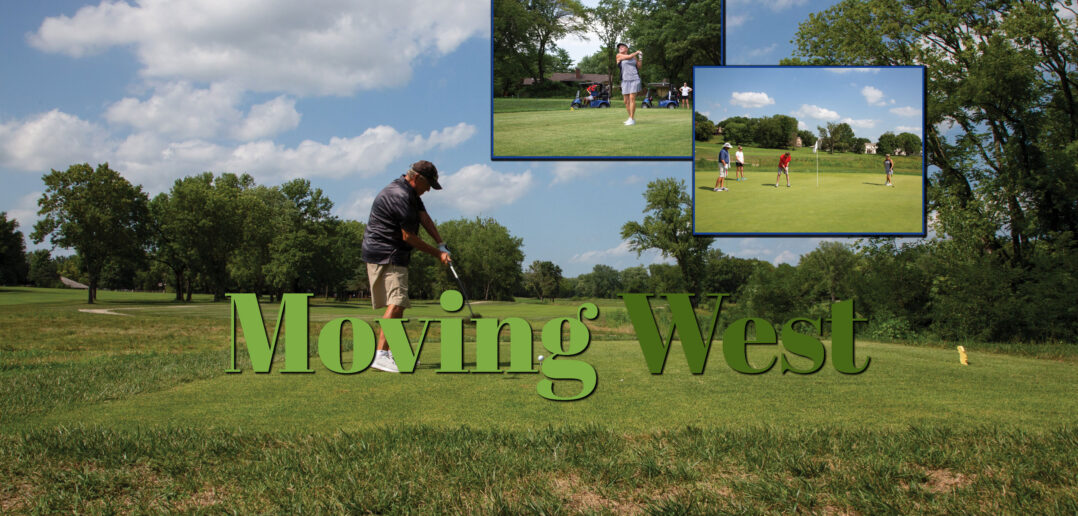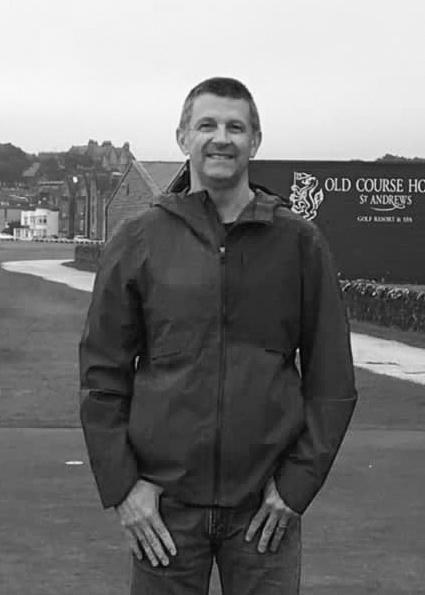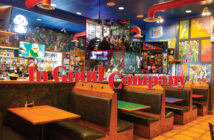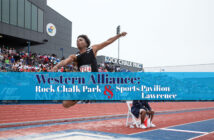| story by | |
| photos by | Steven Hertzog |
| OPEN A PDF OF THE ARTICLE |
Alvamar, home to many of Lawrence’s most prominent and successful businesses and organizations, spurred the growth of Lawrence west of Iowa all the way to Clinton Lake.
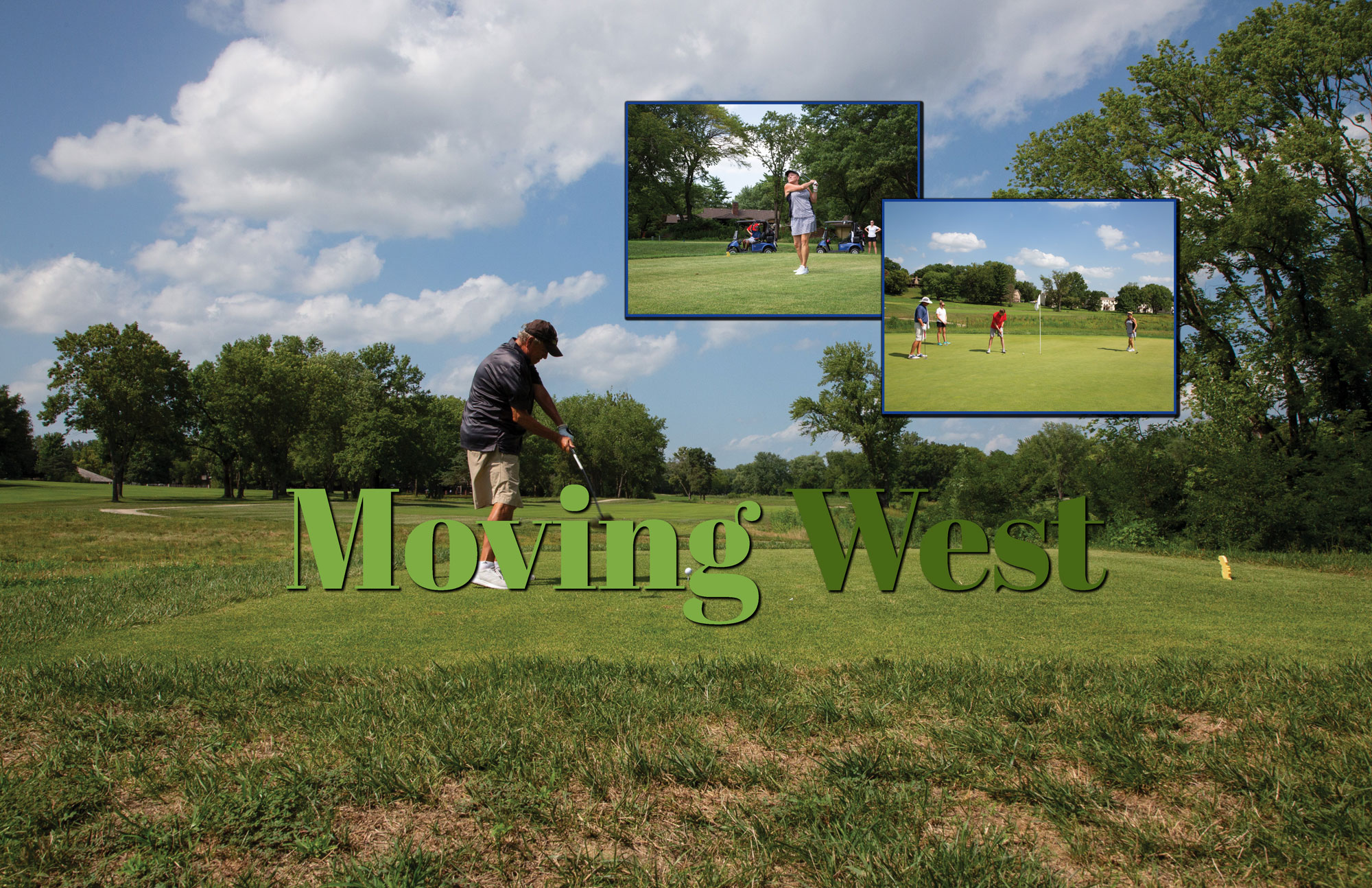
Teeing off and putting on the Alvamar Golf Course
Many of life’s splendors occur when chance moments—coincidences really—grow into seismic events that leave lasting effects on many. Two people accidentally bump into each other in a hallway, end up falling in love and in a marriage that lasts 50 years. Explorers in the 19th century decide to pitch a tent next to a river as an overnight camping space, and a city emerges that today hosts millions. A scientist’s accident becomes the world’s next great invention.
And sometimes, two longtime friends bump into each other, chat about building a golf course and set an entire city on a path for future growth and development.
That, in essence, is the story behind the genesis of Alvamar, the 3,000-plus-acre golf/suburban living/recreation/business/research development that, from the 1970s to up to a few years ago, spurred the growth of Lawrence west of Iowa Street all the way to Clinton Lake.
Once upon a time, the prevailing wisdom was that the city would expand east, toward Kansas City, eventually growing into a metroplex that would include towns that already dotted that landscape: Eudora, DeSoto, Tonganoxie, Bonner Springs. Alvamar, along with some preferable land characteristics that included lushly forested rolling hills and skirted away from flood-prone portions of the Kansas and Wakarusa rivers, changed all that.
What began in the late ’60s as a 460-acre, 18-hole public golf course quickly grew into 3,000-plus acres and 55 parcels of land with more than 30 subdivisions including residential and commercial real estate, parkland and all the needed infrastructure to sustain it. Alvamar is home to many of Lawrence’s most prominent and successful businesses and organizations, such as Landplan Engineering and the Golf Course Superintendents Association of America.
It’s no wonder Alvamar has been referred to as a “city within a city.”
“The original plan was to build something that not only the people of Lawrence would enjoy but would also be appealing enough to attract people from Kansas City,” says longtime Lawrence real estate developer John McGrew, who partnered with good friend Bob Billings on the golf course project, which quickly would expand into much more.
“It was slow in the beginning,” McGrew says. “I think we originally had 27 lots off Kasold (Drive) when it was just a rock road. The first house we sold for $35,000, which was way more than anything being built.
“As soon as people from Kansas City were coming over to play golf, there was more demand, a lot more traffic. It made for a good environment for business.”
An understatement, to be sure. While Lawrence’s core business district on Massachusetts Street maintains its vitality as the city’s core, Alvamar, which was sold several years ago (the public golf course and country club today is The Jayhawk Club), remains to longtime Lawrence residents as synonymous with West Lawrence.
Of course, Billings had a lot of help from investors, engineers, city officials and others in realizing the dream that was Alvamar. But ask just about anyone, and they’ll tell you the credit for developing Alvamar leads back to one man.
“The city bet on Bob Billings,” McGrew says. “And they bet on a winner.”
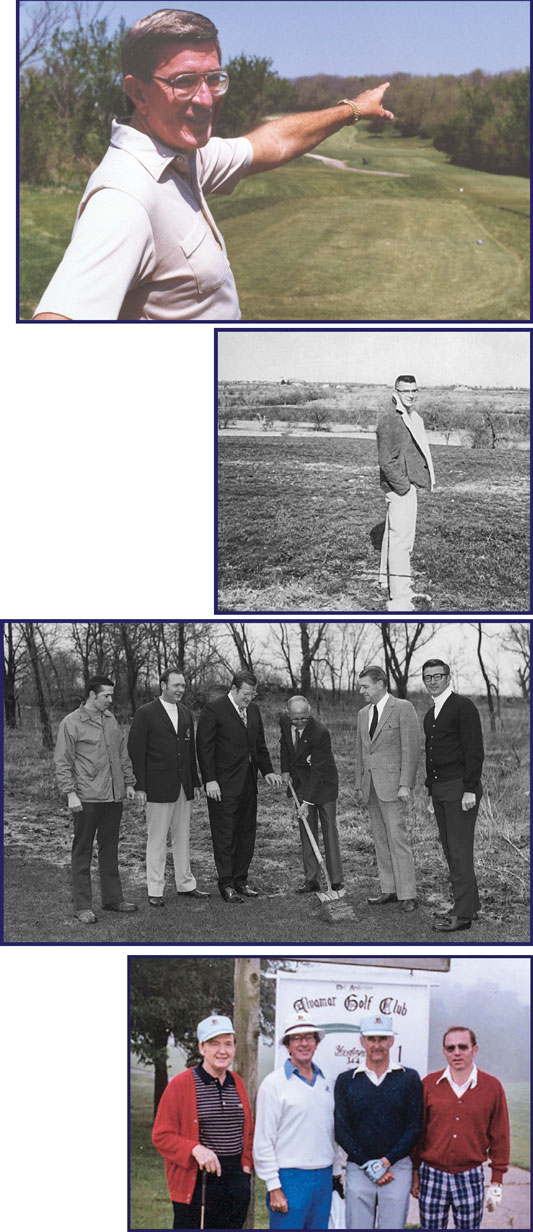
Bob Billings, the eternal optimist, appears to be pointing to the future; Bob standing in the empty fields that he turned into his vision – Alvamar; 29 At a ground breaking, Mel Anderson is second from the left and Bob is on the right; Mel Anderson, Bob Billings, Doug Shade, and Jack Brand pose at Alvamar Golf Club. Photos courtesy Bev Billings.
Beginnings
Billings, a former University of Kansas (KU) basketball player (he played with Wilt Chamberlain on the Jayhawks team that played in the 1957 NCAA championship game) and student body president who graduated Phi Beta Kappa, majoring in economics, business and political science, always referred to the development of Alvamar as an accident, and indeed, the plan came about as the product of a chance meeting with a longtime friend.
Melvin Anderson, golf course superintendent at Lawrence Country Club at the time, was in the pro shop one day speaking with the manager about how he thought Lawrence badly needed a public golf course when he spotted good friends Billings and McGrew walking off the 18th green, having just completed a round. He decided to approach the twosome to say hello and just happened to bring up the thought to his friends.
“I’d played a little golf with Bob,” says Anderson, who’s retired and living in St. Joseph, Missouri. “At that time, he was director of Student Aid and Awards at KU. It was 1965, and I remember talking to him about a public golf course in Lawrence. His immediate response was, ‘Mel, start looking for the ground. I’d love to do that.’ ”
Anyone who ever knew Billings would not be surprised by the response. The native of Russell, Kansas, who died in 2003 following a battle with cancer, was widely regarded in community and university circles as an exceptional achiever, the ultimate people person and an eternal optimist.
“Bob was the most generous person I’ve ever known,” says Beverly Billings, Bob’s wife who worked closely with him during much of the development of Alvamar. “He was always looking out for the best interests of Lawrence.”
Anderson went about studying local geological surveys and topographical maps seeking the best location for a top-notch, 18-hole public golf course.
“You couldn’t really go south, east or north because of the Kansas River, the way it snaked around and through everything,” McGrew says. “There was really no development west of Iowa.”
Anderson says, “We were looking at things such as how (the land) drained, how the course would fit. Topography was 80 to 90 percent of it.”
Billings and his partners settled on buying land that had been occupied by Windy Hill Farm, just west of Kasold and between what was then 15th and 23rd streets. They began building the golf course in 1967.
Billings named the golf course and development Alvamar in honor of both of his parents, Alva and Margaretta. In the original agreement, Billings owned 75 percent and McGrew owned the other 25.
According to a chapter on Alvamar in the 2001 publication “Embattled Lawrence: Conflict & Community,” by Dennis Doomer and Barbara Watkins, there were several factors favoring the development at the time. By the late 1960s, Americans were fleeing city cores for protected, suburban lifestyles on the edges. The political economy at the time was good, with financial incentives and low-interest loans readily available. Land was relatively cheap at the time, as were insurance premiums and taxes.
Then, there was the growth of Lawrence.
In the decade from 1960 to 1970, the city grew from 32,858 to 45,698, a 40-percent increase. KU experienced even greater growth in student population, from 9,325 in 1960 to 17,947 in 1970, an increase of 90 percent.
Then-City Manager Ray Wells, knowing that Clinton Reservoir was coming online in 1980, threw the new development an additional lifeline by committing to run a water line from the city’s treatment plant down by the Kansas River all the way out west. The golf course now had its water source.
Anderson, who had experimented with stolonization of zoysia grass at his previous position at the St. Joseph Country Club and other courses, was instrumental in planting fairways, tee boxes and greens on the new course. Stolonization involved stripping stolons from the zoysia by grinding sod and spreading it with manure spreaders.
“No one could afford to sod an entire golf course with zoysia,” he says.
In all, Anderson says 980,000 yards of soil was shipped in for the project. One hundred fifty to 200 miles of irrigation tubing was installed. And thanks to Anderson’s stolonization method, he was able to take sod from an $800, 2-acre nursery and plant more than $500,000 worth of grass on the initial 18 holes.
The 7,485-yard, par-72, 18-hole championship course opened in 1968 as the first course in the country with zoysia grass from stolonization for all 18 fairways and tees. It regularly received acclaim by Golf Digest and other publications as one of the top 50 public golf courses in the United States.
“Alvamar is as fine a conditioned course as you’ll play,” golf professional Jim Colbert said in 1975. “The only greens I’ve played that are as good are at the Masters.”
A second 18 holes was built in the 1970s, which would become the private Alvamar Country Club. An executive nine-hole course, The Orchards, opened in 1979 off what was then 15th Street. It was sold in 1992. The Alvamar Racquet Club also opened in the 1970s. It was sold in 2002 and today is Bishop Seabury School.
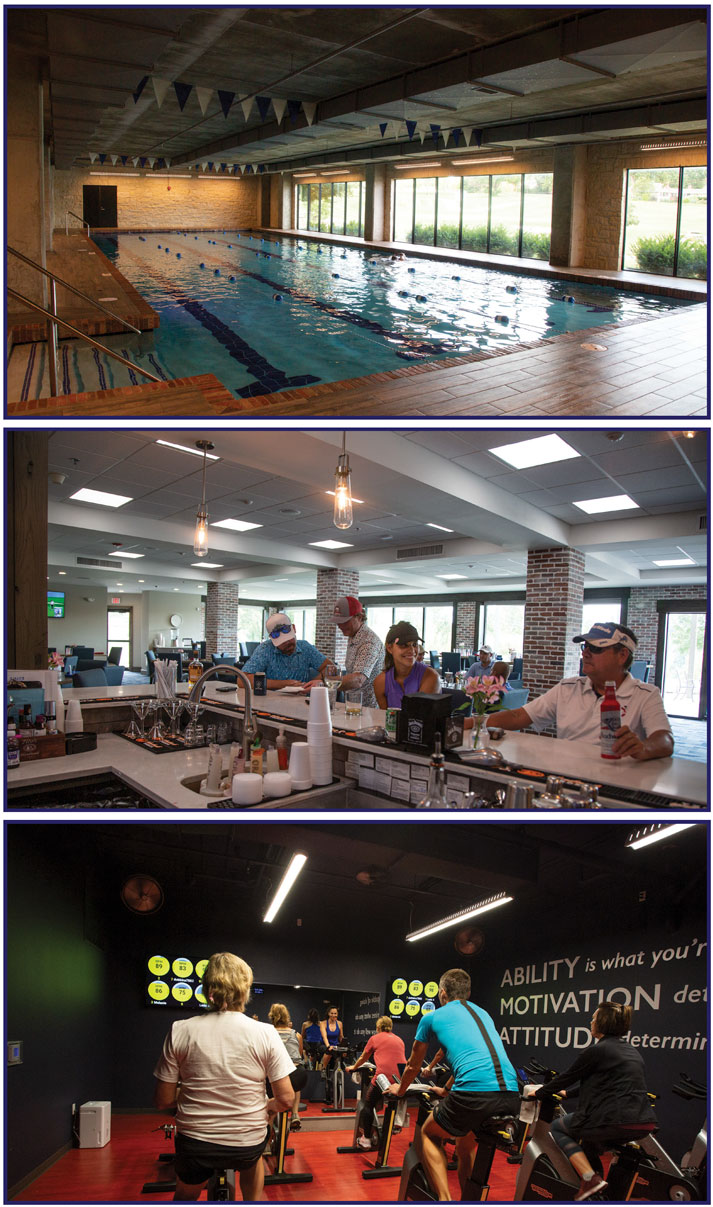
Indoor swimming pool; Eating, drinking and relaxing at the bar; Morning Cycling class;
More Than Just Golf
Initially, Billings didn’t have anything more than a golf course in mind, but it didn’t take long for him and McGrew to realize that, to be financially feasible, land surrounding the golf course would have to be developed with homes and attractive suburban neighborhoods.
After Alvamar Estates, with its $2,000 to $3,500 lots and houses valued at $35,000, homes were quickly snapped up, demand grew so great that Billings began to develop one subdivision after another. Alvamar Heights, Woodfield, The Masters, Prestwick, Quail Run, Foxfire, The Reserve at Alvamar … all went up in quick succession.
Alvamar eventually became the largest single, primarily residential development in the U.S. in a city the size of Lawrence.
With the exploding residential expansion came the rapid growth of commerce, ultimately creating 300 acres and 66 lots planned and developed at the corner of 15th and Wakarusa. It was named Oread West Corporate & Research Park, and attracted such cutting-edge companies as Oread Labs, Campbell-Becker Inc., Comdisco Systems and Strata Environmental Services. Eventually, development expanded all the way out to the new South Lawrence Trafficway. Some communities, such as the Corpus Christi Community, centered around churches constructed in the area. Others were made into open park spaces. One of Billings’ favorite projects was Brandon Woods, an adult-care facility.
Lawrence was fortunate to have a developer such as Billings. Unlike many developers, who come into an area, develop it, make some money and leave, he was personally and emotionally involved with Alvamar and had a genuine love affair with the community. Over the years, he borrowed some $8 million personally, while Alvamar Inc. borrowed another $5 to $7 million, and he worked on the project for nearly 40 years.
“Not only was Bob fulfilling his dream,” Beverly Billings says, “but he was doing good for the city. He changed one little part of Lawrence and made it a better place.”
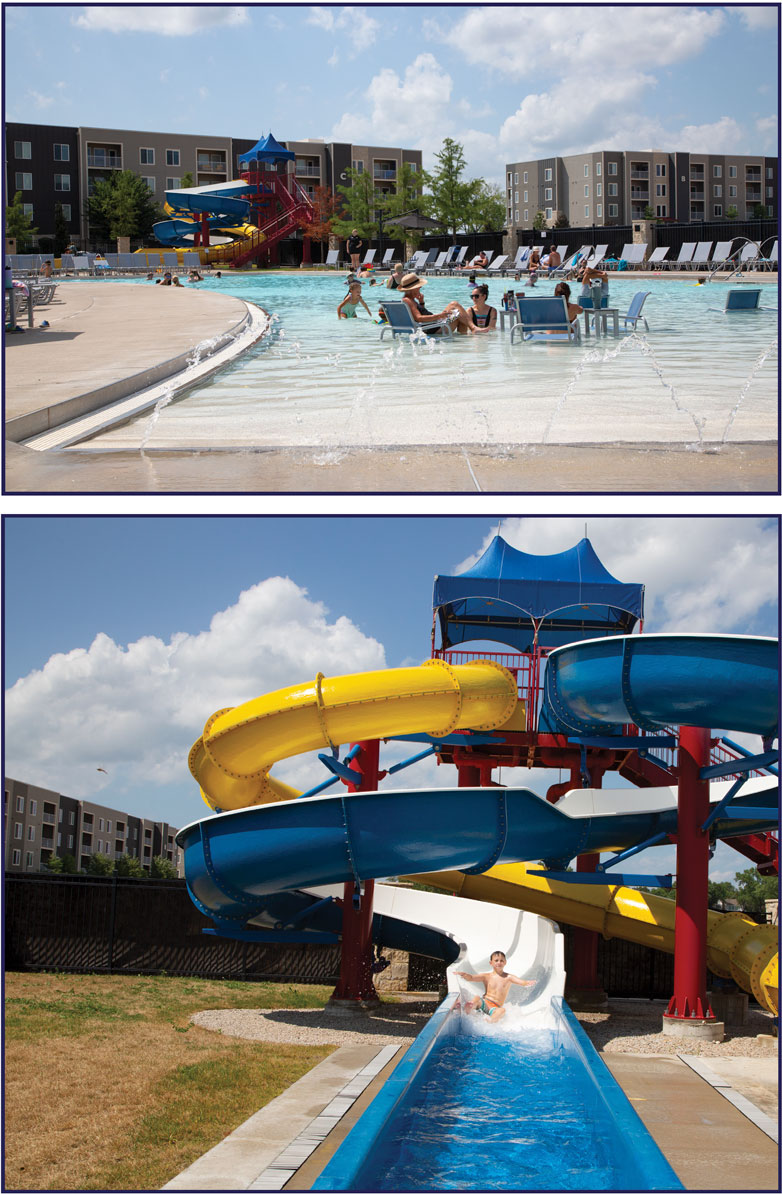
Staying cool at the outdoor pool; side by side water slides
The Jayhawk Club
As the years clicked a decade into the 21st century, the golf boom initiated in the late 1990s by Tiger Woods was abating, and the golf industry was faced with an overabundance of golf courses competing for golfing dollars. This especially was true in the Kansas City area, where it seemed a new golf course was popping up on the horizon every week. Golfers were staying closer to home and no longer traveling to Lawrence for a round at Alvamar.
Following Billings’ death in 2003, Alvamar was beginning to show its age, especially the public-course clubhouse.
In late 2015, Alvamar was sold to Eagle 1968, owned by longtime Lawrence residents Thomas and Dru Fritzel. The golf course became completely private in December 2016, and in February of 2017, it officially became The Jayhawk Club.
The Fritzels immediately began updating the golf facility. All of the greens were rebuilt. Several holes were rerouted, in the end leaving one 18-hole championship course, which opened fully in June 2019. Part of the old, public side of the golf course was developed for the KU men’s and women’s golf teams to have a state-of-the-art practice facility.
An outdoor pool opened in June 2017, and next door, a wellness center featuring weight and exercise areas, as well as a saltwater lap pool, opened in January 2018.
“Thomas’ whole idea was to improve this place while maintaining the Alvamar history,” says Wes Lynch, general manager of memberships, The Jayhawk Club. “I think we brought a reverence to this area. We have a real passion for this place and what we’re doing.”
McGrew says his late friend Billings would probably be pleased with The Jayhawk Club’s continuing ties to KU and its golf programs, less pleased with the changes to the golf course. But if there was one thing Billings knew well, it was that time marches on, things change, and adaptability is a necessity in keeping communities vital and strong.
“Bob was a real optimist,” McGrew says. “He always had very real emotional ties to Alvamar. He wanted it to be a real benefit to the community.
“I’m not sure everyone agrees … . But, to me, it was.”

